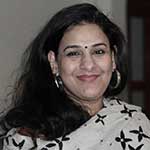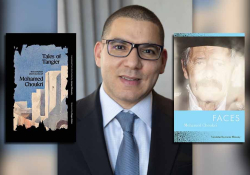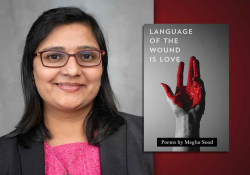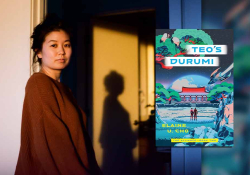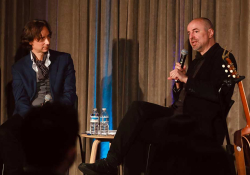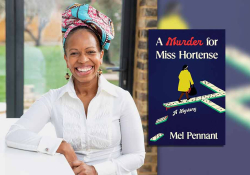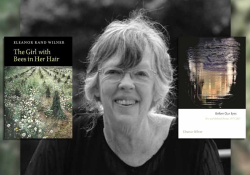Of Tibetans’ Disenchantment, Reclamation, and New Literacy Space: In Conversation with Tenzin Dickie
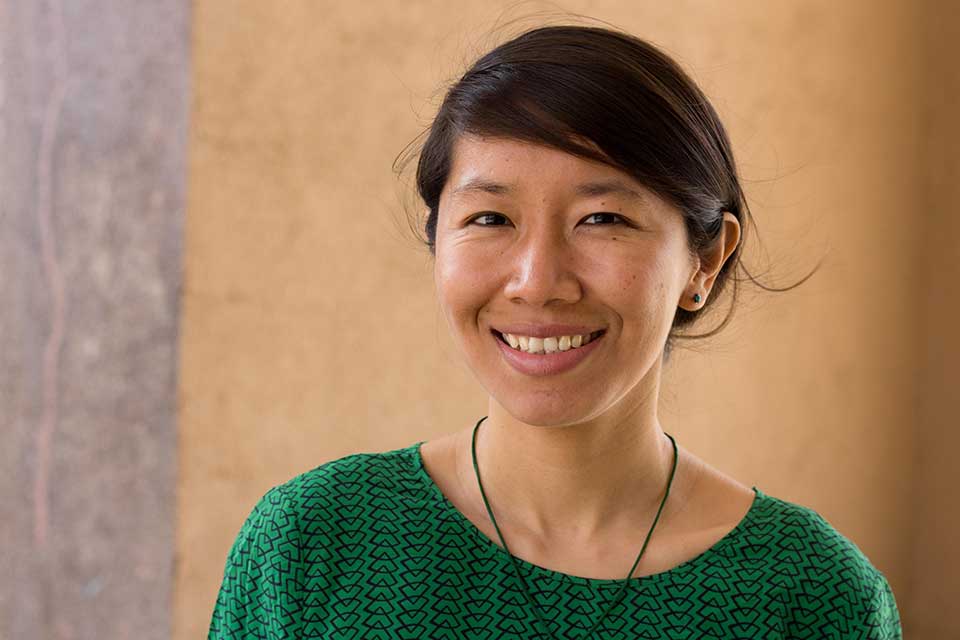
Tenzin Dickie is a Tibetan writer and translator and editor of The Treasury of Lives, a biographical encyclopedia of Tibet, Inner Asia, and the Himalayan region. Her edited anthology, Old Demons, New Deities: 21 Short Stories from Tibet, was published in 2017 by OR Books. She holds an MFA in fiction and literary translation from Columbia and a BA in English literature from Harvard. She is currently a Fulbright fellow in Kathmandu.
Shelly Bhoil: You explain in the introduction to Old Demons, New Deities that fiction begins with desire, and desire is a non-Buddhist ideal that was demonized in old Tibet, which led to the delay of the organic evolution of Tibetan fiction. Can we say that the coming out of this first-ever collection of Tibetan stories in English signifies Tibetans’ disenchantment with religion?
Tenzin Dickie: I do think that’s fair to say. Most Tibetan writers used to write about religion, about Buddhist philosophy and metaphysics and epistemology. They all pretty much came out of the monastic tradition and wrote about things that tradition cared about, which was emptiness and cessation of suffering and enlightenment and not love, honor, betrayal, redemption, and loss. The epic of Gesar and the Sixth Dalai Lama Tsangyang Gyatso’s love poetry were the great exceptions. Otherwise, these were books about getting to nirvana and not about making an accommodation in samsara.
It was only later that the Buddhist religion lost its monopoly on Tibetan intellectual life. It would have been nice to get to make this change gradually and voluntarily, but we didn’t get to choose, and we were forced, which has left its scars on all of us. I think Tibetans are disenchanted with a great many things, not just religion. We are disenchanted with occupation, with assimilation, with exile, with diaspora, with politics, with religion. We are disenchanted with enchantment itself! You know, the Tibetan life-writing tradition has always been hagiographical rather than strictly biographical, which is one way of saying we have insisted on seeing the divine instead of the human, when actually it’s far more interesting and inspiring to see the human.
Bhoil: Indeed, the Tibetan literary trends in the past dealt with religious themes and tropes and thus tended to idealize rather than humanize literary subjects. Even the popular but handful of secular works of Tibetan literature such as the Epic of Gesar Ling existed outside the mainstream. While Old Demons, New Deities signals the rupture from Tibetan society’s overwhelming religiosity in the past, does it also manifest a continuity of tradition?
Dickie: Actually, literature such as the epic of King Gesar was very popular and quite mainstream, especially for eastern Tibetans even more than central Tibetans, I think. I think in the same way that in the West, you have phrases and quotations from the Bible floating in the air, so to speak, and in India, you have the Mahabharata, Tibetans used to have Gesar. Just the other day, my mother was trying to describe to me an older lady who was beautiful and my mother said, “She played Drugmo in the school operas.” Enough said. And my mother is from Kyirong, which is about as far away on the Tibetan plateau as you can get from places claiming to be Gesar’s Ling.
As far as Old Demons, New Deities signaling rupture or continuity, I don’t think it’s rupture or continuity, I think it’s rupture and continuity. That’s kind of what I think it feels like for many of my generation. We were cut off from our historical past, quite literally. We were cut off from our historical literature and culture, those of us growing up in exile or in occupied Tibet, but we are still so connected in ways that the CCP can’t quite fathom.
Take Woeser, one of our most famous writers. She grew up speaking Chinese, going to Chinese school, and she writes her poetry, fiction, and essays in Chinese. As an adult, she decided to learn Tibetan and worked hard on it even though there are not many people for her to speak Tibetan with in Beijing, where she lives. It was important to her to reclaim her heritage. It’s important to all of us. To know where we are going, we have to know where we come from. Dhondup Gyal studied the Dunhuang documents, some of the oldest Tibetan literature, before making that radical break from traditional poetry and innovating modern Tibetan poetry and launching modern Tibetan fiction.
Bhoil: Gesar Ling, however, wasn’t part of the official or canonical Tibetan literature despite its popularity and the fact that it is known as the longest epic in the world. It was even banned in several monasteries of central Tibet because of its secular content. It’s interesting how this epic has outlived the challenges across centuries and that many, like your mother from Kyirong, relate to it. Coming to your mention of Woeser, I see her as an example of how with dedicated, conscious efforts one can reclaim the lost heritage even in a non-Tibetan setting. How far are you confident about the representation of Tibetan identity in the short stories, some in English and others in English translation, in your anthology?
Dickie: I think the representation of Tibetans in fiction, the depiction of ordinary flawed people in short stories and novels, is one of the great advances of our time. Tibetans didn’t write short stories or novels. They wrote treatises about this doctrine or that and commentaries on sutras, which you needed a monastic university education to access. Our literature has become much more democratized. My friend’s brother, Rinchen Namgyal, read Old Demons, New Deities, and he was especially struck by Dhondup Tashi Rekjong’s short story “Dolma.” He said to me afterward that he had never read a story about a Tibetan boy falling in love before. It’s such a universal experience, falling in or out of love, and it’s only now in our generation that our writers are putting them down in words that the ordinary person can read. From Dokhar’s premodern novel to Dhondup Gyal’s short stories to Thubten Samphel’s Falling through the Roof, we already have quite an evolution. When we look at short stories that Tibetans are writing now, whether these are Pema Bhum’s in Tibetan or Woeser’s in Chinese or Tsering Wangmo Dhompa’s in English, I feel like the representation of ordinary Tibetan life, full of complexity, is more possible now than ever before. Add to that the fact that now we have women writers! Women are writing their lives—women are not just wives or mothers but authors of our own stories.
Bhoil: I like what you just said about Tibetan women becoming authors of their stories. In fact, looking back at the history of Tibetan National Uprising in Lhasa in March 1959, women were the first ones to go out in the streets shouting anti-China slogans, taking the political destiny of Tibet in their hands. Can you throw some light on your selection of women writers in Old Demons, New Deities and the women characters in the Tibetan short stories?
Dickie: Writing is a very private enterprise that, at some point when you publish, becomes a public enterprise. And as is the case with other public platforms in Tibetan society, there are very few Tibetan women writers compared to men. I wanted to include more women in Old Demons, New Deities, and there are women writers who write poetry or essays, but I didn’t know who else wrote good short stories. So Old Demons, New Deities ended up with only four women writers out of sixteen writers.
Among those included is Tsering Wangmo Dhompa’s “Letter for Love,” in which we have young college-going (or about to be going to college) Karma writing letters for the people in her community in Nepal. She’s the scribe, which is traditionally a very male occupation, as only men, and only very certain men at that, knew how to write. Karma is transcribing the lives of the people in her community. Karma’s mother, Tsering, arranges a new life for her friend Pema, orchestrating a letter-writing campaign that her daughter Karma helps carry out with her “English.” Tsering dictates for Pema, and Karma writes the words down, with the result that Pema goes off to her new life in America, Karma has her own Indian-college future ahead of her, and Tsering is left, with her own life—a life that’s half gone and a future that’s vague and murky, not very hopeful, yet still full of desire. The story is essentially an exploration of female desire, and as such it’s a feminist project. It’s about women possessing, owning, managing, postponing, orchestrating desire and the written word. Of course, Dhompa being the great writer that she is, the story is also just a story about the inner lives of three very real women.
How we shape our narratives, who gets to tell our stories, from which point of view, all that has very real consequences because we live and relive our stories. Writers are better at whatever they pay more attention to, and women writers pay more attention to the interior lives of women than male writers do. That said, I have to single out another female character in the book who just fascinates me—Dolma, who is the creation of Dhondup Tashi Rekjong, a male writer. For the narrator, who is a schoolboy in Amdo when we first meet him, Dolma is an unknowable object of desire. She disappears from his life, and he continues to desire her. Later he reconnects with her as a young man and finds out what he thinks is her real nature. What’s fascinating for me is that for the narrator, Dolma remains trapped in this Madonna/whore complex; but for the reader, she totally manages to escape the Madonna/whore paradigm to become her own very real person, with her conflicting desires and choices and choosing to have choices. She becomes known and yet remains unknowable, as happens with our own loved ones: they become known completely and yet remain essentially unknowable.
The Chinese occupation of Tibet means that our actual territorial space is occupied, leaving us only virtual spaces. We Tibetans have to create our own commons because our real common space, our commons—Tibet, the plateau—has been privatized.
Bhoil: In Old Demons, New Deities, I see an interesting intersection of geographies, as the authors of the short stories are placed across the globe. What were your motivations and method in organizing the common literary space for Tibetans living in far corners of the world?
Dickie: The Chinese occupation of Tibet means that our actual territorial space is occupied, leaving us only virtual spaces. We Tibetans have to create our own commons because our real common space, our commons—Tibet, the plateau—has been privatized. Taken, stolen, privatized by the CCP. So we have to work all the harder to create what would have been natural extensions of the national culture—literary space, political space, cultural space. And we have to create our own gathering spaces—CTA’s Five Fifty initiatives; Office of Tibet’s Garrison events; SFT’s training camps and conferences, Machik Weekend, Tibetan parties, Irish Bar! These are all important spaces in their various ways.
I also wanted to push back against this corrupted idea, an idea proposed by the Chinese Communist Party of course, that exiled Tibetans are not real Tibetans, that only the Tibetans in Tibet are the real Tibetans. That exile Tibetan politics is not real Tibetan politics, that exile Tibetan literature is not real Tibetan literature. Woeser lives in Beijing, Pema Bhum lives in New York, Jamyang Norbu lives in Tennessee, Tsering Wangmo Dhompa lives in Philadelphia, Tsundue and Bhuchung live in Dharamsala! There’s no more Tibetan Tibetan than the Dalai Lama, who lives in Dharamsala in exile. It’s not his choice—or rather it’s not a free choice; it’s a forced choice, living in Dharamsala.
I also wanted to push back against this corrupted idea, an idea proposed by the Chinese Communist Party of course, that exiled Tibetans are not real Tibetans, that only the Tibetans in Tibet are the real Tibetans.
Bhoil: I see that translation, which has been a dominant literary tradition in Tibet since the seventh century BC, is a seminal tool in the creation of Old Demons, New Deities. How did you arrange the translation of some stories from Tibetan and Chinese into English, and what were the challenges you faced in the process?
Dickie: Yes, translation is a big part of this book. Of course, translation must generally be a big part of the cultural enterprise for any nation that is small in size but has a massive, outsized appetite for knowledge, wisdom, and literature. So translation is just a big part of Tibetan literature in general. In terms of my translations of the stories, well, I actually had an enormous kind of autonomy, which was very freeing but also scary. It meant a huge responsibility. For instance, it wasn’t like Kyabchen Dedrol or Tsering Dondrup was going to read the English version and say he disagreed with this or that stylistic choice, you know! So I kind of had to get it right.
Some problems always arise with translation from the Tibetan. For instance, Tibetan has no articles, whereas in English, each common noun has to have an “a,” “an,” or “the” prefixed to it—so Tibetan sometimes gets to have a built-in ambiguity that isn’t allowed in English, which can require more specificity. In those cases, how specific should I get? How specific would the author get if he were writing in another language and not Tibetan? For a writer like Pema Bhum, who tends toward short sentences at times, how do I preserve that clarity and brevity without it sounding choppy in English? Translation involves so much choice, and how do I know my choices are right? There are very few translators of contemporary Tibetan literature, which is even an improvement from a few years ago. Dechen Pemba, Bhuchung D. Sonam, Christopher Peacock, Michael Monhart, and a handful of others are doing excellent work. But there’s an immense volume of work that needs to be translated and so many writers who have not been translated. I would love to get to a time when there’s a multitude of translators and some of us get to translate the same works, and that will allow for real discussions over voice and tone and translation aesthetics.
The interesting thing about Tibetan writing in English is that it’s coming from an exile that’s waiting to return, which means that it’s a deterritorialized literature that is obsessed with place, with territory.
Bhoil: With Old Demons, New Deities, we might say that Tibetan fiction in English or in English translation has taken a step forward from its cursory stage. Do you think Tibetan fiction writers are adequately equipped to forge their own body of writing? What is your assessment of the future of Tibetan fiction, especially in English?
Dickie: What a kind thing to say, Shelly! With the rise of writer coteries in Tibet, especially these writing groups based in Amdo such as the Third Generation, and in Dharamsala centered around TibetWrites/Blackneck (which I consider myself a member of, even when I am in New York or Kathmandu), we Tibetan writers are certainly forging our own body of writing. The interesting thing about Tibetan writing in English is that it’s coming from an exile that’s waiting to return, which means that it’s a deterritorialized literature that is obsessed with place, with territory.
For TibetWrites/Blackneck, we have to thank Tenzin Tsundue and Bhuchung D. Sonam, who have done a lot of work promoting Tibetan literature over the years. To speak more of their recent writing in Old Demons, New Deities, I think that with “The Connection,” Bhuchung has essentially created the Tibetan genre story. It’s a Tibetan thriller story and a brilliant piece of writing. I would love to see more such stories from him. Tsundue’s story “Zumki’s Snowlion” is a beautiful, whimsical story that plays with the myth of the snow lion in twenty-first-century Dharamsala. He’s known more for his poetry and essays, but he’s a gifted fiction writer, too, and I’m hoping to see a great Tibetan novel from Tenzin Tsundue someday. Jamyang Norbu’s much-awaited literary memoir is coming out. When George Orwell becomes more translated and better known to Tibetan readers, he’ll be known as the English Jamyang Norbu. Topden Tsering’s essays are coming out, so is T. N. Khortsa’s novel. Pema Tseden’s short-story collection just got published in English, and up next is Tsering Dondrup’s. The late great editor of Tibetan Review, Tenzin Wangyal, has a novel that will see daylight soon. My assessment of the future of Tibetan writing? It’s here!
My assessment of the future of Tibetan writing? It’s here!
Bhoil: Which one is your favorite story in the collection?
Dickie: Isn’t that like asking a parent to choose their favorite child! I really shouldn’t say.
Bhoil: What’s coming next from your desk?
Dickie: I am working on a family memoir, my family’s story of exile, diaspora, and resettlement. After the Chinese army came, my family left Tibet in the 1960s and spent some years in makeshift refugee camps on the Nepalese highlands before moving down to the Tibetan refugee settlements in India. I was born in the Kullu-Manali valley and had the mandatory Kullu-Manali childhood of stealing golden apples from the orchards everywhere. From Himachal Pradesh, we left for Boston, Massachusetts, in the 1990s, through the Tibetan provisions of the 1990 Immigration Act. So I’m spending a year in Kathmandu working on these narratives. I am also working on a translation of Pema Bhum’s memoir of his teacher Dorje Tsering. Pema Bhum is one of the most respected scholars and practitioners of modern Tibetan literature. His teacher, Dorje Tsering, was one of the great unrecognized figures of the Cultural Revolution who essentially helped save the Tibetan language in his area of Tibet. After the devastation of the Cultural Revolution, he was a key figure in the resurrection of the Tibetan language in Amdo, and this work is Pema Bhum’s homage to this heroic and yet unknown figure.
December 2018
